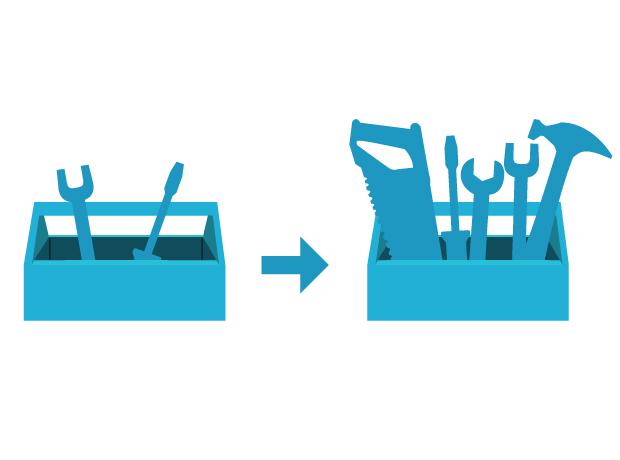Expanding our Design Toolbox with Lean UX

Recently Grio’s design team has adopted Lean UX that enabled us to expand our design toolbox in the following ways:
- Conduct in-depth Discovery and Research to define the products
- Inject a user-centric design focus
- Incorporate “deep collaboration” internally, as well as with our clients
By “deep collaboration”, I mean utilizing everyone’s strengths by digging deep with all members of the team (designers, developers, managers, the client, etc.), asking strategic questions and co-creating with the client. All of this leads to extraordinary ideas and more effective solutions. If you’d like to learn more about “deep collaboration” in design and you have a www.lynda.com account, you can watch Lauren Bacon’s talk on “Collaborative Design: Vision and Strategy”.
These strategies along with the utilization of both Agile and Lean UX design processes resulted in a successful product definition and client relationship.
We would like to share with you this process and the methods used in a series of blog posts.
Today’s blog post is 1 of 9.
For this blog post I’ll explain Lean UX principles and how we used a variety of methods in different phases of this project.
We were drawn to the Lean UX process because at the core of it is a repeated cycle of designing, prototyping, and testing that ultimately delivers an MVP (which was our goal). The quicker you can get an MVP to market, the better you can learn what is working or not working and iterate on the product over time.
Another core principle of Lean UX is user-centered design. You’re prioritizing their needs, wants and experiences of the product and/or service at every stage of the design process which delivers a more successful product.
Principles that contributed to our success include the following:
- Waste removal: Lean UX attempts to create design artifacts or living documents that keep the team and process moving forward. In some cases, document deliverables are considered wasteful and time consuming whereas living documents are valuable because they are continuously referenced throughout the duration of the project. Furthermore, this particular project involved several stakeholders and other individuals on the team who couldn’t always be involved in every meeting or workshop we did, therefore documenting our findings and progress proved to be extremely valuable as it kept everyone aligned and provided transparency.
- Cross-functional collaboration: Non-designers are brought into the process at all stages and designers become design facilitators instead of design heroes.
- Rapid experimentation and measurement: This process allows us to quickly learn how well design solutions meet our client’s goals and our user’s needs. The measurements of experimentation are based on hypothesis statements created in the research phase.
Another aspect of Lean UX is the organization of the design phases. Ours was as follows:
- Planning & Discovery: This phase enables us to get focused, organized, and align with the client and team on priorities and goals. This is also an opportunity to begin learning about our target users.
- Research: Research methods enable us to learn directly and indirectly what users need, want and experience, which will influence how we design the product so that it is optimized to deliver on those needs. During this phase we also analyze the client’s competitive space to inform the product design and ideas are buzzing! Both the Discovery and Research phase are messy by nature and can start off abstract, but this is normal. Once we get to the design phase the messiness begins to go away.
- Design: This phase enables us to explore, define, and document design solutions, product features, product personality, who it’s designed for and what activities it encourages. We design the information architecture, interaction design, and UI during this phase and communicate these to our developers.
- Testing & Validation: These methods help us figure out if the design is successful; will users be able to use the product or service as intended? Does the product trigger positive emotional responses? How fluid and seamless does the user experience feel overall?
- Design / Prototype / Test Iteration: This cycle is repeated and focuses on specific features we determined were the highest risk or important to get right for the product to be successful. This phase encourages close collaboration with the entire team – designers and non-designers alike.
At Grio we’re flexible in our design process and often times we don’t get the opportunity to conduct such in-depth Discovery and Research. Even if it can be challenging and more work up front, it has been proven to us that Lean UX is an extremely valuable approach that we will use for many projects in the future.
Here is a list of methods we used:
- Kickoff Meeting
- UX Questionnaire
- Project Plan
- Project Brief
- Workshop: Review Project Brief
- Strategy Workshop: Vision & Focus
- Learning Plan
- Product Characteristics
- Guerilla User Research
- Proto Personas
- Competitive Analysis
- Comparative Assessment
- Assumptions Worksheet
- Hypothesis Statements
- Workshop: Project Priorities
- Sitemap
- Design Concept (Proposal)
- Design Studio (Sketching)
- User Task Flows
- High Fidelity Mockups
- Prototypes (Interactive)
- Black Hat Session
- Quick-and-Dirty Usability Test
- Five-Second Test
- Usability Testing
In future posts in this series we’ll illustrate some of these methods in detail and explain why the Lean UX approach is valuable for us and can be valuable to you, too!